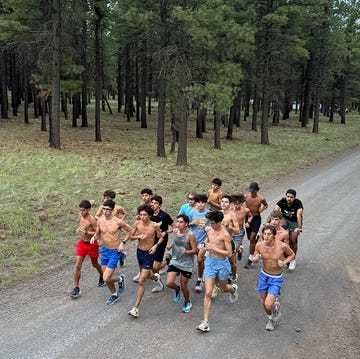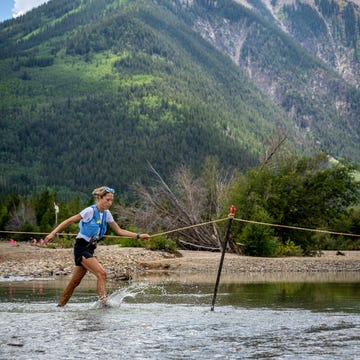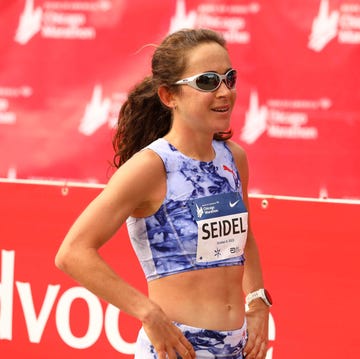It’s been 24 years since Alan Webb shocked the running world and shattered Jim Ryun’s seemingly untouchable high school mile record with a stunning 3:53.43 effort in the 2001 Prefontaine Classic.
Running in the loaded mile race at the old Hayward Field in Eugene, Oregon, Webb, wearing his blue and white racing kit from South Lakes High School in Virginia, not only outran Ryun’s 36-year-old mark of 3:55.3, but he did so with a dramatic kick off the top of the last turn that landed him in fifth place overall. Morocco’s legendary Hicham El Guerrouj won that race 3:49.92 and brought Webb along within him on his victory lap.
“That day changed my life,” said Webb, who went on to break Steve Scott’s American record in the mile with a 3:46.91 as a Nike-sponsored pro in 2007.
Will anyone ever break Webb’s high school record? Webb certainly thinks so.
“I’ll just say that no record is safe,” he told Runner’s World last week. “We’ll see if it survives this summer.”
After Owen Powell (3:36.49) and Josiah Tostenson (3:36.85) ran so fast in a professional 1500-meter race at the Portland Track Festival on June 15 in Portland, Oregon, it certainly seems possible. Although they came up just short of Hobbs Kessler’s 3:34.36 1500 national high school record, their times, the second- and third- fastest in U.S. history, respectively, convert to the 3:52-3:53 range for a mile, theoretically faster than what Webb ran.
Future teammates
However, the opportunities for Powell or Tostenson to get in a fast race and go after Webb’s outdoor mark are dwindling, as both are outgoing seniors who are heading to the University of Washington in the fall—where they will be coached by Powell’s parents, Andy and Maurica Powell, the Huskies head coaches.
Powell, 18, who just graduated from Washington’s Mercer Island High School, owns a 4:02.04 outdoor mile personal best from 2024, while Tostenson, 19, who graduated from Crater High School in Central Point, Oregon, has run 3:59.00 outdoors this year. (Both runners ran the 1600 meters during their high school seasons, which is 9 meters shorter than a mile.)
Powell broke through with a 3:57.74 indoor mile effort on February 15 at the University of Washington’s Husky Invitational, then he shaved a full second off of Kessler’s indoor American record by running 3:56.66 a week later in a race on Boston University’s famously fast indoor track. In the same meet, Tostenson ran 3:57.47 in the following heat, while his high school teammate Tayvon Kitchen ran 3:59.61.
Powell and Tostenson rank fourth and fifth, respectively, on the U.S. high school absolute list (including indoor and outdoor results), while Kitchen ranks No. 27.
Powell will get what might be his final chance to go after Webb’s record on July 5 at the 50th edition of the Prefontaine Classic in Eugene. He’s been invited to compete in the International Mile, which is the meet’s second-tier pro mile race that precedes the star-studded, meet-ending Bowerman Mile.
“It’s kind of scary, that’s for sure,” Powell told DyeStat this week. “You have all these high schoolers hyping up the sub-4 and everything, but the difference between 3:53 and 3:59 just feels like a big gap. But I think that's something hopefully I’m ready for. I’m excited to give it a shot. I think I’m in the fittest, best shape of my life. I have time goals in mind, but in the end, I’ll just be happy with myself this weekend if I can just run as hard as I can.”
The Prefontaine Classic will be broadcast live on NBC and livestreamed on Peacock (subscription required) from 4-6 p.m. ET.
Mercer Island coach Susan Empey thinks Powell can break Webb’s record, so much so that she’s cutting short a dream vacation this week in Italy to get back in time to watch it unfold in Eugene. She believes Powell’s fitness and recent racing efforts show he’s ready to run fast, but she knows he’ll have to stay in the thick of things and keep working hard when the going gets rough on the third lap.
In addition to the fast 1500 Powell ran, he also lowered his personal best in the 800 meters (1:46.63) when he placed a close second behind Cooper Lutkenhaus in the 800 meters at the Brooks PR Invitational on June 8.
“By no means do I think running a sub 3:53.4 will be easy, but I 100 percent believe he is right where he needs to be to do so,” Empey said. “All of his recent workouts indicate he is ready, and the two most recent races he’s done also point to that possibility.”
The Prefontaine meet doesn’t hold a mile undercard race every year, but when it has it’s often been relatively fast. Most recently, Geordie Beamish won the International Mile in 2021 in 3:54.86, while Australia’s Luke Matthews took the title in 3:57.02 in 2018. The last time it was won faster than Webb’s 3:53.43 was in 2017 when Brazil’s Thiago André (3:51.99) outran British runner Chris O’Hare (3:53.34) and Norway’s Henrik Ingebrigtsen (3:53.79).
This year’s International Mile is loaded with sub-3:52 runners, led by New Zealand’s Samuel Tanner, who placed 11th in the Bowerman Mile in 2023 (3:49.51), and Vincent Ciattei, who last year finished fourth in the 1500 meters at the U.S. Olympic Trials and just lowered his personal best with a 3:49.37 effort at the June 12 Bislett Games Diamond League meet in Oslo, Norway.
Other top runners in the 15-runner field as of July 2 include former North Carolina star Ethan Strand, who lowered the NCAA record to 3:48.32 on February 1 at an indoor meet in Boston, University of Virginia runner Gary Martin, who placed fifth in the Wanamaker Mile (3:48.82) on February 8 in New York City, and Luke Houser (3:51.14), the 2025 World Indoor Championships 1500-meter bronze medalist.
The only runner in the field with a slower seeding time than Powell is New Zealand 16-year-old phenom Sam Ruthe (4:01.72 this year), who last year became the first 15-year-old runner to break the 4:00 barrier.
“Unless the race goes out at a ridiculous (for him) pace, I’d remind him when he hits that third lap to lean into the discomfort, remember all the practice he’s had running these paces, and know that both his body and brain can handle it,” Empey said. “He knows he’s been given an amazing opportunity and he will not let it go to waste. And his best races are the ones where he reminds himself this is for fun, and he just focuses on racing the people. And in this heat there will certainly be some great people to race.”
Faster high school runners
Webb became the first high school runner to break the 4-minute barrier indoors, running 3:59.86 in January 2001. That made him just the fourth U.S. high school runner in history to break 4:00, behind Ryun, Tim Danielson, and Marty Liquori. Ryun, who still holds the second-fastest time behind Webb, did it the first time as a 17-year-old junior in June of 1964, when he ran 3:59.0 at a meet in Los Angeles.
Ryun went on to compete in the 1964, 1968, and 1972 Olympics for the U.S., earning the silver medal in the 1500 meters in the ‘68 Games in Mexico City. He also lowered the world record in the mile twice, with his career-best of 3:51.1 in 1967 remaining for nine years.
Powell and Tostenson were the 24th and 25th U.S. prep runners to achieve the sub-4 distinction and the first two of seven to do it this year. In all, 30 different high school runners have broken 4 minutes a total of 44 times.
“Owen clearly has a lot of raw ability, but I think what has put him in a position to chase Alan’s record is that he’s had a very measured approach to his training all four years of high school,” Empey said. “There have been no setbacks, the mileage increases year over year were very moderate, and he is one to always stay within the parameters of each workout. I think it would be easy for someone like him to hammer every workout and see how fast he can run every interval, but he truly respects the process and doesn’t get greedy. Also it’s the things he does outside of running that have also enabled him to be in this position. He takes the recovery piece of training just as seriously as he does the running. From a coaches perspective you could not ask for more.”
Webb believes more high school athletes are running faster times because of high-tech super shoes and spikes, but also because of NIL funding, improved training and the ability to watch races via livestreams and proliferation of results and highlights on social media. (Powell signed an NIL deal with On in April.)
“It’s an entirely different world,” said Webb, who wore a pair of Zoom Kennedy spikes with scant cushioning. “You could say that myself and Dathan (Ritzenhein) and Ryan (Hall) were at the beginning of DyeStat getting going and then FloTrack, and now it's like a whole industry. You can watch races on livestream, and even if you don't livestream it, you can still go online and get the results and look at the splits while it’s happening.”
The fastest outdoor high school mile time of 2025 (3:58.65) belongs to Quentin Nauman, a junior from Dubuque, Iowa, who edged out Tostenson to win the elite high school race at the Hoka Festival of Miles race on June 5 in St. Louis.
Nauman said he hoped to go after Webb’s record at Nike Outdoor Nationals on June 22 in Eugene. Ultimately, that race didn’t go out fast enough and Nauman opted for a sit-and-kick race strategy, but he still won in 4:00.52 by narrowly outleaning Evan Noonan (4:00.53) at the finish tape.
Tostenson was disappointed not to be invited to the Prefontaine Meet but believes the only way to break Webb’s record is to get into a fast, elite-level race.
“I've been aware of Webb’s record since my freshman year after I ran a 4:09 and set the (freshman) record,” he said. “Back then my thinking was that I’d just be grateful to go sub-4 at some point. That record seemed untouchable, and it honestly still seemed untouchable going into this year, but then out of nowhere it all of a sudden doesn't seem so untouchable anymore.”
Brian Metzler is a Boulder, Colorado, writer and editor whose work has appeared in Runner’s World, Sports Illustrated, ESPN, Outside, Trail Runner, The Chicago Tribune, and Red Bulletin. He’s a former walk-on college middle-distance runner who has transitioned to trail running and pack burro racing in Colorado.
















